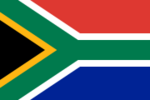Eleven official languages are spoken in the country on the Horn of Africa – a reflection of the population’s diversity. But it took until 1994 for all its citizens to be granted the same rights. Although white rule ended more than a quarter of a century ago and South Africa is now one of the leading newly industrialized nations, everyday life continues to be marked by poverty and inequality. With 20,000 murders occurring each year, the crimes of the apartheid regime are increasingly fading into the background.
Credit: András Osvát / CC BY-SA 3.0
The Legacy of Apartheid
![[Translate to Englisch:] Eingang Apartheid-Museum](/fileadmin/_processed_/9/8/csm_Entrance_to_the_museum_of_apartheid._Johannesburg._South_Africa_bearb_889c9183b7.jpg)
Credit: JukoFF / CC BY-SA 4.0
South Africa – officially the Republic of South Africa – is the most economically developed nation in Africa. It is the only country on the continent that belongs to the G20. Almost 60 million people live here on more than 1.2 million square kilometers. Black Africans make up the largest share of the population (almost 80 percent), while Whites and Coloureds each make up just under nine percent. Until the early 1990s, there was a policy of strict racial segregation in South Africa with massive privileges for Whites.
The first white colonizers on the southern tip of Africa were Dutch. They set up a supply station at the Cape of Good Hope in 1652, which soon expanded. Slaves from Asia and Madagascar were forced to work for the Cape Dutch – the Boers (farmers). They later retreated into the hinterland after Great Britain established the Cape as a colony and banned slavery. But the British also conquered these Boer republics. All four colonies merged in 1910 to form the Union of South Africa, which effectively became independent in 1926. In 1961, the Union became the Republic of South Africa.
Since the beginning of the 20th century, numerous regulations ensured that white residents in South Africa enjoyed considerable privileges. Blacks, Coloureds and Asians were not allowed to vote. In addition, they could only acquire land in certain areas. From 1948 onwards, the policy of racial segregation was systematically expanded. The authorities divided the inhabitants into “Natives,” “Whites,” “Coloureds” and “Asians”; “mixed marriages” were forbidden. More than three and a half million Blacks were forcibly resettled in so-called homelands. Through “apartheid” (segregation), the descendants of the European immigrants secured their supremacy while continuing to benefit from cheap labor.
As South Africa’s economy boomed in the 1960s, domestic and foreign political conflicts intensified. The self-confidence of younger blacks in particular grew. In 1960, following violent protests, the main opposition organizations – ANC and PAC – were banned and their leaders arrested. They received support, however, from the Soviet Union, Cuba and East Germany, which enabled them to continue the armed struggle from underground. International sanctions against the apartheid regime finally triggered a growing capital flight in the 1980s.
It was against this background that the newly elected president Frederik Willem de Klerk decided to change course in 1989. Liberation organizations such as the African National Congress (ANC) were readmitted, and its leader, Nelson Mandela, was released from prison after 27 years. In 1991, a number of apartheid laws were declared invalid and a National Peace Agreement was signed. Government and opposition representatives negotiated a provisional constitution and free elections.
Paradoxically, far more South Africans became victims of political violence during this transitional period than in the previous four decades. This was mainly due to conflicts between the ANC and the black, anti-communist Inkatha Freedom Party (IFP), which claimed at least 14,000 victims. That South Africa did not descend into chaos at that time was mainly thanks to Mandela, who was elected president in 1994 and repeatedly called for reconciliation.
In 1996, the freely elected parliament adopted a new constitution with equal rights for all citizens. A Truth and Reconciliation Commission began its work the same year. Under the leadership of the black Archbishop Desmond Tutu, it tried to investigate the violent acts of the past – while also offering forgiveness to the perpetrators. South Africa thus became a model country for coming to terms with its past peacefully. But contrary to hopes, this did not bring the violence to an end. On the contrary, tribalism, xenophobia and corruption have led to repeated eruptions of bloody unrest in recent years (as of July 2021).
Republic of South Africa

Area: | 1,221,037 km² |
Inhabitants: | 59.62 million (2020, estimated) |
Population growth: | 1.3 % annually (2019, estimated) |
Population density: | 48,83 inhabitants per km² |
Seat of government: | Pretoria |
Official language: | Afrikaans, English and nine African languages |
Political system: | Federal Republic |
Head of state: | President Cyril Ramaphosa (since 2018) |
Head of govt.: | President Cyril Ramaphosa (since 2018) |
Freedom status: | 74/100 |
BIP per capita: | 12,962 USD (adjusted for purchasing power, 2019) |
(ኢትዮጵያ)
(تونس)
(République démocratique du Congo)
(الصومال)
(جيبوتي)
(مصر)
(الجزائر)
(Côte d'Ivoire)
(إرتريا)
(The Gambia)
(Cameroun)
(République du Congo)
(ليبيا)
(المغرب)
(موريتانيا)
(Moçambique)
(السودان)
(South Sudan)
(تشاد)
(الصحراء الغربية)
(République centrafricaine)